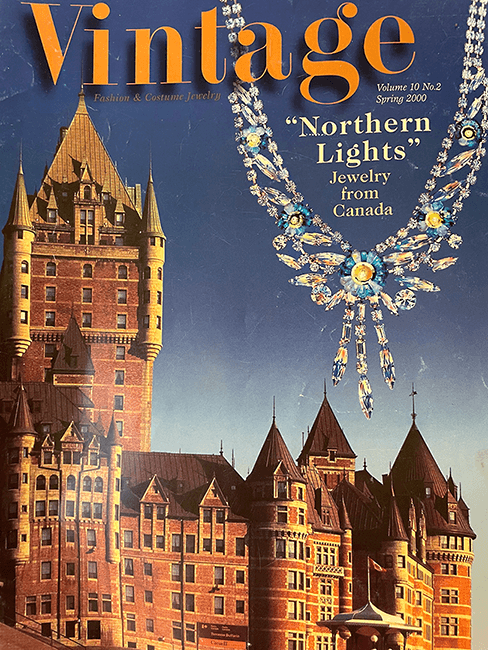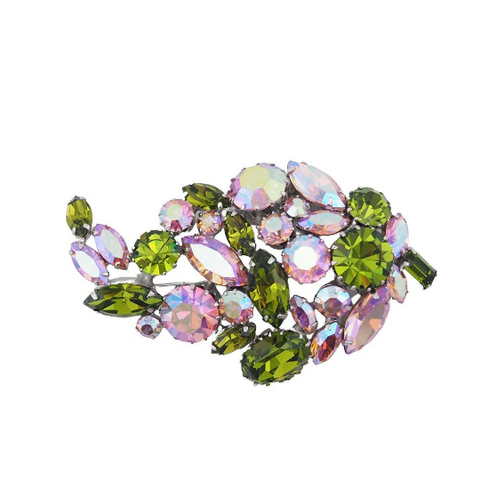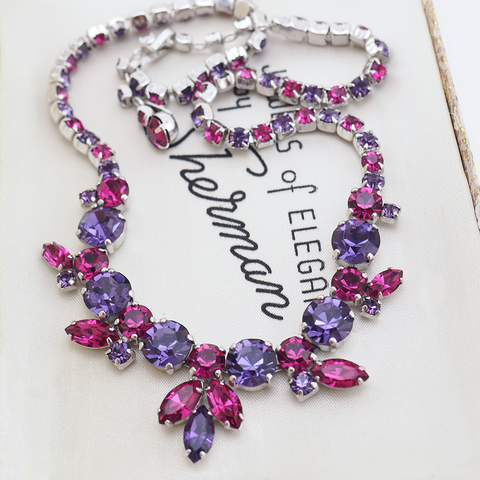Sherman Jewelry History

Sherman Jewelry History
 Shop our selection of Sherman Jewelry.
Shop our selection of Sherman Jewelry. 
Jewelry by G.Sherman & Company LTD
*Article reproduced from the Spring 2000 Vintage Fashion & Costume Jewelry Magazine
*All images and text on this site are subject to copyright.
The following article on Sherman jewelry history has been reproduced from Vintage Fashion & Costume Jewelry Volume 10 No2 from Spring 2000. It was written by long-time collector Terry Delany and republished with permission from the author. Terry has informed me that there was an error in the publication and the necklace shown on the front cover of the magazine is marked Keyes, not Sherman.
Gustave Sherman

Canada at its best!
Jewels of Elegance, the phrase written on the paper foil tag attached to Sherman jewelry captures the ambiance of elegance, sophistication and quality that Gustave Sherman created with costume jewelry. Sherman is to Canadian costume jewelry what Gretzky is to Canadian hockey and Celine Dion is to Canadian music. Sherman is the most recognized and collectible costume jewelry in Canada.
From 1947 until 1981 in Montreal, Quebec, Sherman manufactured uniquely designed, quality, signed jewelry, utilizing subtle shades of colors, and uniting balance of size with a sense of movement.
He oversaw every facet of his business including design, production and marketing. More than fifty years after Gus Sherman started his jewelry business, even the beginner Sherman collector can pick out of a case Sherman’s jewels at an antique show or store.
He used Swarovski stones, and designed styles which required large numbers of stones, and finished his jewelry with double plating. He also had a ‘no question asked’ free repair service for all of his jewelry. Some of his former staff tell of Sherman completely remaking a bracelet and of receiving, by mistake, competitors broken jewelry, which he also repaired without charge.
The school of hard knocks
The key to Sherman’s design, manufacturing, and marketing brilliance is tied directly to his life experiences; spiritually, culturally and through ‘the school of hard knocks.’ Sherman’s character
is representative of so many Canadian and American citizens born in the early nineteen hundreds. His parents were first generation immigrants who had fled persecution and poverty in eastern Europe and had come to a new land believing in the chance of a better future for their children. The parents ingrained in their children the belief that honest, hard work would bring success in a country where they were free to exercise religious and cultural beliefs. One of his former workers described his employer’s two obsessions, his business and his family, which included his parents, brothers and a sister, as well as his wife and two children.
Innovator and perfectionist
An innovator in design of costume jewelry, Gus Sherman had an unerring ability to know the range of taste in jewelry from a farmer’s wife to a high society matron. His son, Mark explained, “My father could have been producing widgets and if he had, they would have been the best widgets ever produced.” Thankfully, Gus Sherman chose to manufacture costume jewelry and not widgets! He set the standard for quality costume jewelry and competed successfully with the other high end costume jewelry designers and manufacturers in Canada – Boucher, Trifari, Keyes, D’Orlan, Jay Kel, and one of the Mazer brothers, Abraham, who owned Avon of Belleville.
A military career
At eighteen, rather than enter a Yeshiva, Gus hitchhiked to Texas and joined the Texas Cavalry. He quickly realized that he did not want to spend the next five years with the cavalry, but did not have the $250 to buy out his contract. He decided to play poker. He won the necessary money and hitchhiked his way back to Canada.
He then paired with a friend and traveled throughout the countryside in Quebec and Ontario buying jewelry from farmers and families in small towns and selling it when they returned to Montreal. Gus joined the Royal Canadian Airforce as a navigator and later sold life insurance. Gus Sherman’s travel, work experiences and military experiences provided him with direct access with ordinary people, who were the hard-working backbone of Canadian communities. With very little money in the thirties, Canadians didn’t buy gem jewelry, but sold their jewelry in order to get by during the difficult times. Sherman got to know their tastes and in the late forties and fifties he realized that there was a market for high end, quality costume jewelry that these people would want to buy.
An emerging talent
A childhood friend, Hy Mendelson, had started selling Jay Kel and Jay Flex jewelry which was owned by a wholesaler from New York. Hy, a genius with machinery, bought a Canadian franchise to manufacture Jay Kel and Jay Flex in Canada. This line of jewelry was rhodium plated sterling with rhinestones. It was very well made and had a sophisticated and a rather dainty appearance.
Gus Sherman began working with his friend and this was the start of his formal training in the costume jewelry business. Within a year, he left Jay Kel and started his own concern (perhaps this is a typo and it meant to say company). He imitated the quality manufacturing techniques he had learned at Jay Kel but he was more interested in design and did not want to be restricted by the wholesale owners’ design edicts. Jimmy Koretza, a Hungarian jeweller, had left Jay Kel with Sherman. He is the only staff person who is mentioned as one of Sherman’s designers. I think that Sherman knew what he wanted in design and Jimmy may well have been able to carry out Sherman’s wishes because of his formal jewelry background.
For the first year, one can definitely see the Jay Kel influence in the Sherman designs, but Gus very quickly expanded and created his own designs which he continued to develop over the next thirty-four years.
An ideal employer
Part of his staff were women who worked At home while their children were young. Additional staff was brought in to work part time in the evenings and on weekends. Sherman’s concern for his employees showed. Positions were kept open when one become ill. He trusted his employees and treated them in an individual manner that enabled them to integrate their personal life with work which was so important in the forties and fifties when women were just beginning to cope with working and raising
families. The very loyal, well trained and experienced staff was one of the important foundations for Sherman’s success. The very few employees who took advantage of Sherman’s working conditions and stole designs which were produced on the side, are spoken of with great disdain by his former staff who still express anger that any employee would not have been loyal to Sherman and his company.
Going upscale
He realized that with the advent of high employment after WWII, the ordinary person had money to buy some luxuries. Many still did not have the funds to buy very expensive gem jewelry but they did have money to buy quality costume jewelry. He made no pretense of mimicking gem jewelry. His jewelry was designed to be recognized as costume, but expensive, quality costume jewelry.

Jewelry to impress
Certainly, one of the reasons that Sherman was so well known across Canada was that he sold his jewelry to all the leading department stores and large luxury jewelry chains such as Birks (the Tiffany of Canada), but the basis of his sales was always the small local jewelry store in every small town even in remote regions of the country. Sherman only sold one price range of jewelry and that was expensive. His pieces varied from classical, small items to the very opulent, extravagantly large bracelets, earrings, brooches and necklaces. Regardless of the size or the design of any of the jewelry, each piece was made to a very high standard and was the most expensive costume jewelry of its style available. There was no such product as a low or economical line of Sherman jewelry. When a husband or a boyfriend wanted to impress his wife or girlfriend, a Sherman piece was what he chose.
The sincerest form of flattery
His friend and competitor, Philip Keyes, recognized that Sherman’s glitzy style incorporating light base metal soldered together was what the customer wanted, resulting in the Hollywood glamour look rather than the smaller, heavier cast fashion jewelry that mimicked the gem jewelry of the thirties. Philip Keyes, who designed and produced fashion jewelry that rivaled Alfred Philippe and Boucher, switched to making the “Sherman” style of jewelry. Keyes mentioned modestly, yet sincerely, “But Sherman was the best in this style of costume jewelry.” Philip Keyes also acknowledged that Sherman would never compromise quality in order to get a contract or a sale.
Not appreciated in his day
Unfortunately, the large department store buyers, and to a certain extent, the consumer, did not appreciate the element of extra quality and the resulting extra cost of Sherman jewelry. The majority of consumers began buying jewelry made by other companies that on the surface looked similar, but did not use the same quality or number of stones or meticulous finish. Because Sherman would not compromise on the quality of his manufacturing or design, he began cutting into his profit margin in order to compete with the cheaper costume jewelry.
Champagne
Forty and fifty years later, the attention to top of the line design and production of quality in Sherman jewelry is being appreciated by collectors. In the 1950s to the 1970s quality was the reason Sherman was considered the champagne of costume jewelry. Unfortunately, Sherman’s insistence on not compromising the quality of jewelry or abandoning his beloved rhinestones or crystal beads as the basis of his jewelry when current fashion of the seventies was switching to the minimalist faux gold and silver look, was the beginning of the end. Ironically, the final business closing was brought about because Sherman decided to start producing quality gem jewelry in large quantities with precious metals. He converted his plant just at the time that the price of gold was over three hundred dollars an ounce and he was forced to close his doors.
Collecting value
Why is Sherman jewelry so collectable today? One of the reasons is the fact that the jewelry can be found across the country and on internet auctions. It is now being collected in the United States and in Europe. There was a great quantity of Sherman produced and it can still be readily found. Another quality that makes it collectable today is that the Sherman look is readily recognizable.
DESIGN CHARACTERISTICS
The color king

Sherman is known for his creative, artistic use of color. It is not uncommon to have five shades of one color of rhinestones in an individual piece. His unending palette of rhinestone color combinations is amazing. I once put out seventy three pieces of blue Sherman jewelry. I was only able to pair five pieces that had the same color combinations in blue tones. I have counted over a thousand different color combinations in Sherman jewelry. Many of his color combinations were offbeat and non-traditional, and were only produced for one season and then withdrawn because they were too dramatic for the average customer. Many of these colors and color combinations are avidly collected today.
The rarest colors of Sherman are black, fuchsia, deep purple, yellow and red. The jewelry that has the black japanned plating with red, white, blue, green stones or fashion pearls and the jewelry with five or six totally different colors in one item are also very collectible and rare. One example of these special stones was the lavender stones called Alexandrite that change color to a light blue in different lights. A top Canadian gemologist, Eve Gagnon, explained that these stones produce a more realistic Alexandrite effect than the very expensive synthetic stones that are currently produced. Swarovski only produced these stones for a very short period, and Sherman’s jewelry using the pale lavender stones in the early fifties are now very sought after.
“The look”
Because of cost of production, the large chokers, wide bracelets, huge brooches and massive drop earrings measuring three to four inches are also rare. These pieces were in the most expensive bracket in the forties and fifties. Because a great number of people couldn’t afford to pay thirty-five to fifty-five dollars for a single necklace or bracelet, these pieces were also not produced in large quantity.
The most popular, and thus the most readily available today are clear rhinestones, aurora borealis, topaz, gold and blue shades. For the collector, the best values can be found in these colors since they are not currently popular colors. I recommend these as good buys because I think the Marilyn Monroe faux diamond look, and the appeal of the aurora borealis stones that can be worn with all colors and the return to favor of the earth tones and blues will bring these pieces of Sherman jewelry back into popularity.
“He would have her completely reset the piece if he didn’t think the color combinations were correct. He would say, “This brooch just doesn’t dance.”
The Sherman ‘look’ which stamps a piece as Sherman on sight is more difficult to describe. There is a common thread, no matter if the piece is very small or huge, that imparts a sense of sophistication and elegance. The lines are classic with the size increasing but carrying out the same basic style. One of Sherman’s senior stone setters, Christina Karpinsky told me that Sherman trusted her to choose the color combinations when she took jewelry home to set. The next morning he insisted upon examining every piece and would have her completely reset the piece if he didn’t think the color combinations were correct. He would say, “This brooch just doesn’t dance.”
Looking at a large display of Sherman jewelry you can recognize the dancing element. Sherman jewelry, even large pieces, used color and line for a wonderful sense of movement.
One creative technique Sherman used was his unique and creative use of stones. He custom ordered stones from Swarovski, made to order for specific pieces of jewelry. They were more expensive than the thirty percent higher line and even more expensive than made-to-order fancy stones. Perhaps because Sherman was in Canada, he was able to use many of the stones that were only being used by Christian Dior, Chanel and a few of the other couture designers. Another distinctive technique was the use of combining Swarovski rhinestones with German art glass cabochons for a line of bib necklaces and brooches with glass drops. He also produced jewelry using stones with unfoiled backing set in reverse in a similar style to Schreiner.

Three dimensional
Another feature of many of Sherman’s designs was a three dimensional effect and great use of layers and domed structures. This jewelry design was very intricate and complex. Sherman used it in many various forms and came to be identified as the Sherman style.
Sherman jewelry has stood the test of time. The extensive hand setting of Swarovski special and custom stones, as well as the use of special effect German and Czechoslovakian stones, coupled with the double plating manufacturing techniques has produced a level of excellence that is appreciated by the collectors of vintage jewelry today. Add to this list of qualities, the consistent, recognizable design style. Combining this with sales to high end boutiques and department stores and to stores in every small community across the nation, has established Sherman as the most recognizable designer of quality costume jewelry that Canada has produced.
I recently bought a Sherman necklace and earrings that I cannot find a similar one of Shermans. The stones are light blue and topaz/sapphire. I would like to know it’s value? Is there someone I can contact about this set of jewellery?
I have some Sherman sets where one or two pieces are signed but one piece isn’t. Also have a couple of brooches that looked to be Sherman quality and found signed pieces that were identical.
Your article is good, exceptional as Sherman.
I heard that every authentic Sherman is signed. If it’s not signed, it’s not a Sherman. Would you please advise if it is true? thank you
I actually have a question and would appreciate it if you respond to my email address. I have collected Sherman jewelry for years. I have pieces that are not signed Sherman, but sure look as beautiful as the signed pieces. Are there such things as unsigned Sherman? I purchased from another collector a pair of earrings. One earring is signed but the other is not. Other than the signature, they are identical. Thank you in advance.
The Sherman jewelry line is so beautiful and has obviously survived the test of time. I was very proud when I found out Mr Sherman was Canadian. The Sherman jewelry was created to be gorgeous but also to be as near perfect as possible with attention to every detail of colour and shape.